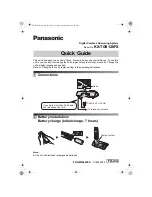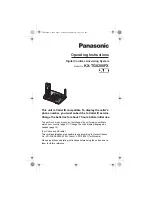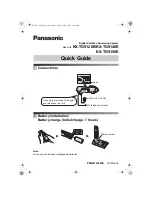
Cause 2:
Erroneous detection because of an echo or an echo canceler.
The sea bottom cable or satellite communication path (4 Line Type)
(Echo/Echo Canceler)
The signal from FAX1 reaches FAX2 via stations 1 and 2, but the reflection signal at station 2 also returns via station 1 (echo).
As the distance between station 1 and station 2 is far, the echo returns to FAX 1 at a max of 600 msec after transmission. There
is a possibility that this signal is detected erroneously as the signal from FAX2. For a normal call, there is also a possibility that
the echo of their own voice will make the call difficult to understand. For this reason, each station (station 1 and station 2)
attaches echo cancelers (S1 and S2) for international lines or long distance lines. For the echo canceler, the level of the
transmission signal from FAX 1 is compared with the level of the reception signal from FAX2. When the transmission signal is
larger, S1 is closed while S2 is opened when it is smaller. In other words, for transmission from FAX1, S1 is closed and S2 is
open, so that the echo does not return to FAX1.
(Causes and Countermeasures)
(Cause A)
When a training signal is transmitted from FAX1 during the communication procedure at the time of transmission from FAX1 to
FAX2, there is a delay until the echo canceler operates. S1 is closed so that a part of the head of the training signal may drop
out. Normal reception by FAX2 may not be possible, and transmission may not be started.
(Countermeasure A)
When the international line mode is ON in the service mode (code No. 521), a dummy signal is attached to the head of the
training signal to prevent this problem. As this is normally ON, it is necessary to reconfirm that this has not become OFF. When
the international mode is switched OFF, the transmission side will try the training signal three times at each speed (9600BPS,
4800BPS and 2400BPS). If NG, it will drop the speed by one rank (fall-back). When the international mode is switched ON,
each speed will be tried only twice. In other words, the slower speed with fewer errors can be accessed more easily. This is
done because the line conditions may deteriorate and the picture may be disturbed more easily during communication for
international lines or long distance communication, even when the training is OK. The default value is ON as preference is given
to clearer pictures rather than speed.
(Cause B)
The echo canceler operation stops with a 2100Hz signal. (i.e. S1 and S2 become ON). Accordingly, when FAX1 has executed
automatic reception, a CED signal is output. If this signal is 2100Hz, S1 and S2 will become ON. Then the echo of the DIS
signal output afterwards may be received and FAX1 may execute an erroneous operation, preventing communication from
starting.
(Countermeasure B)
In the service mode, the CED signal frequency is set to 1100 Hz (code No.520), or the time setting between the CED signal and
the DIS signal is set from 75 msec to 500 msec in the service mode (code No.593). This is because the echo canceler operation
stop mode is canceled by an interval of 250 msec or more.
Reduce receiving sensitivity to reduce the effect of RCV echo signal. (Service mode: code No. 598)
47
KX-FP101AL
Summary of Contents for KX-FP101AL
Page 7: ...1 11 ITU T Test Chart Actual size 7 KX FP101AL ...
Page 9: ...1 12 2 CONTROL PANEL 9 KX FP101AL ...
Page 18: ...1 14 12 REPLACING THE FILM CARTRIDGE 18 KX FP101AL ...
Page 19: ...19 KX FP101AL ...
Page 29: ...2 3 3 TROUBLESHOOTING ITEMS TABLE 29 KX FP101AL ...
Page 30: ...2 3 3 1 Simple Check List 30 KX FP101AL ...
Page 32: ...2 Document JAM 32 KX FP101AL ...
Page 36: ...6 Paper JAM 7 Multiple feed and skew 36 KX FP101AL ...
Page 39: ...Fig C 12 A blank page is received 39 KX FP101AL ...
Page 43: ...2 3 3 3 1 Defective facsimile section 1 Transmit problem 43 KX FP101AL ...
Page 50: ...50 KX FP101AL ...
Page 51: ...51 KX FP101AL ...
Page 52: ...52 KX FP101AL ...
Page 53: ...53 KX FP101AL ...
Page 54: ...54 KX FP101AL ...
Page 55: ...55 KX FP101AL ...
Page 56: ...56 KX FP101AL ...
Page 57: ...57 KX FP101AL ...
Page 65: ...I O and Pin No Diagram 65 KX FP101AL ...
Page 67: ...67 KX FP101AL ...
Page 68: ...68 KX FP101AL ...
Page 69: ...2 3 3 4 2 Check the Status of the Digital Board 69 KX FP101AL ...
Page 73: ...2 Troubleshooting Flow Chart 73 KX FP101AL ...
Page 75: ...2 3 3 7 Operation Panel Section 1 No key operation 2 No LCD indication 75 KX FP101AL ...
Page 78: ...2 3 3 9 CIS Contact Image Sensor Section Refer to 6 4 4 SCANNING BLOCK 78 KX FP101AL ...
Page 79: ...79 KX FP101AL ...
Page 80: ...2 3 3 10 Thermal Head Section Refer to 6 4 3 THERMAL HEAD 80 KX FP101AL ...
Page 93: ...2 4 7 3 PRINTOUT EXAMPLE 93 KX FP101AL ...
Page 94: ...94 KX FP101AL ...
Page 97: ...2 5 3 PRINT TEST PATTERN 1 Platen roller Reference pattern 97 KX FP101AL ...
Page 98: ...2 Left margin Top margin Reference pattern 98 KX FP101AL ...
Page 99: ...3 Thermal head 1 dot Reference pattern 99 KX FP101AL ...
Page 122: ...6 3 2 MEMORY MAP 122 KX FP101AL ...
Page 134: ...134 KX FP101AL ...
Page 144: ...6 4 6 3 2 Transmitting documents 6 4 6 3 3 Receiving FAX 144 KX FP101AL ...
Page 145: ...6 4 6 3 4 Copying 145 KX FP101AL ...
Page 163: ...163 KX FP101AL ...
Page 171: ...7 1 MEMO 171 KX FP101AL ...
Page 172: ...172 KX FP101AL ...
Page 176: ...9 1 MEMO KX FP101AL 176 ...
Page 180: ...11 1 MEMO KX FP101AL 180 ...
Page 182: ...12 1 MEMO KX FP101AL 182 ...
Page 184: ...13 1 MEMO KX FP101AL 184 ...
Page 186: ...14 1 MEMO KX FP101AL 186 ...
Page 188: ...15 1 MEMO KX FP101AL 188 ...
Page 189: ...16 TERMINAL GUIDE OF THE IC S TRANSISTORS AND DIODES 189 KX FP101AL ...
Page 190: ...17 FIXTURES AND TOOLS 190 KX FP101AL ...
Page 192: ...18 2 UPPER CABINET SECTION 192 KX FP101AL ...
Page 193: ...18 2 1 PICK UP BASE SECTION 193 KX FP101AL ...
Page 194: ...18 3 LOWER P C B SECTION 194 KX FP101AL ...
Page 195: ...18 4 MOTOR SECTION 195 KX FP101AL ...
Page 196: ...18 5 ACTUAL SIZE OF SCREWS AND WASHER 196 KX FP101AL ...
Page 197: ...19 ACCESSORIES AND PACKING MATERIALS 197 KX FP101AL ...
















































